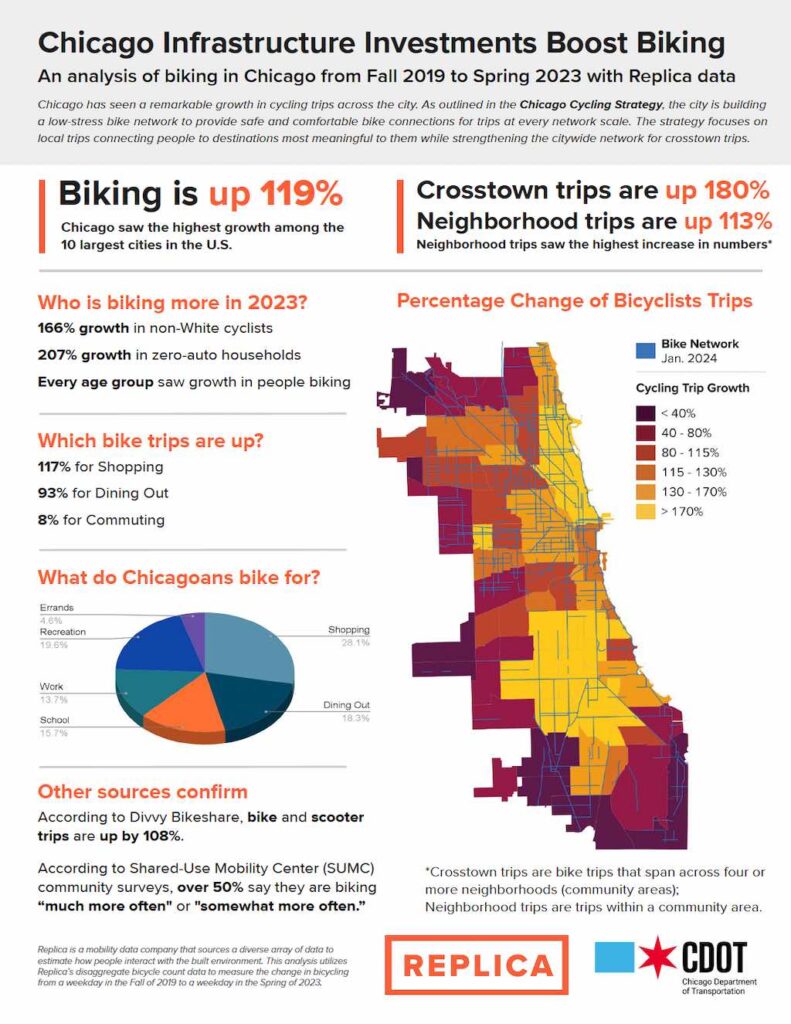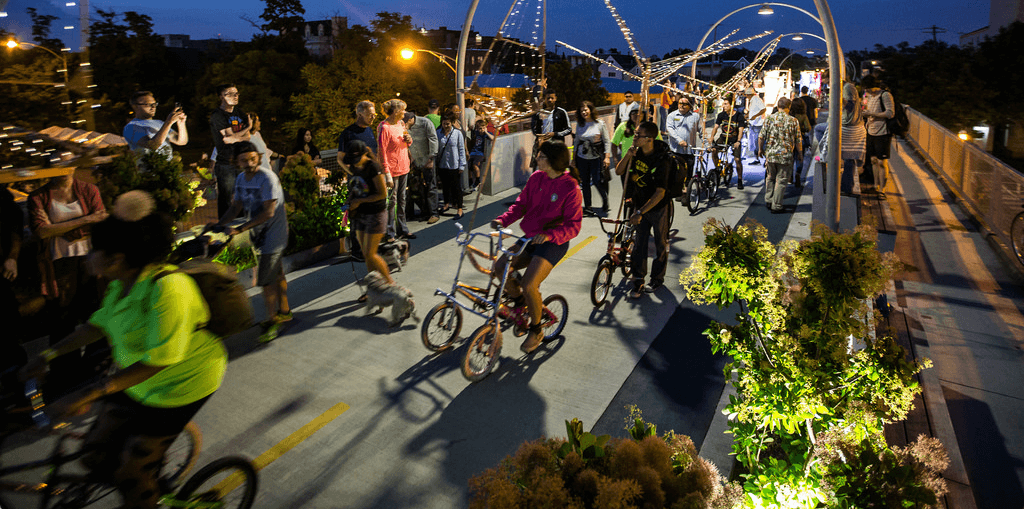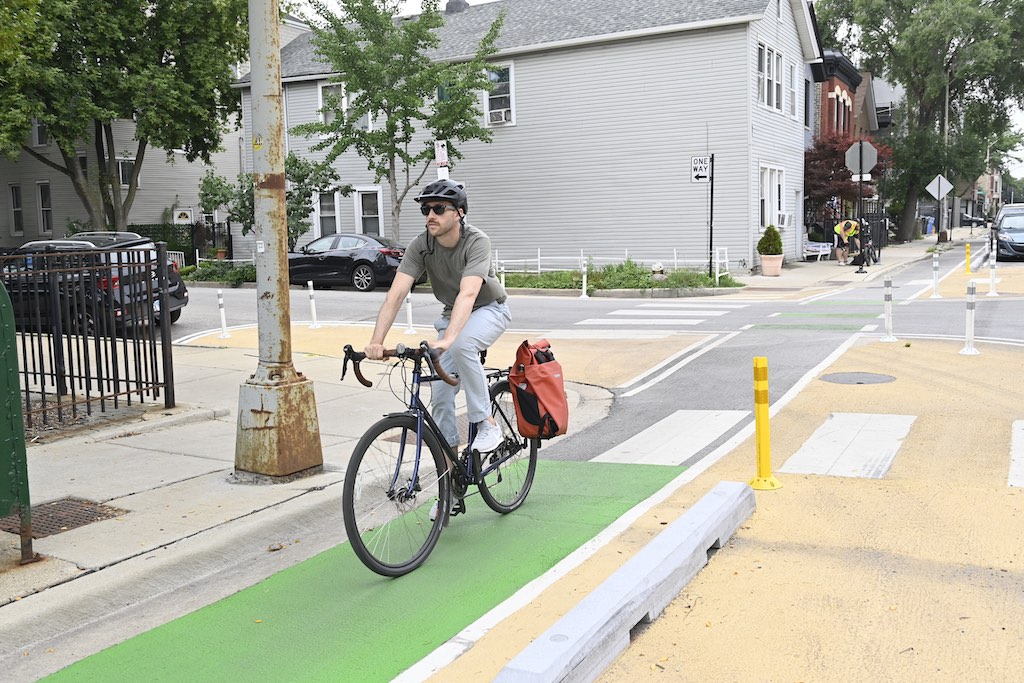Autumn Gear Guide
Find inspiration in our Gear Guide that will keep you out on your bike through wind or rain.
Download NowChicago is in the midst of a biking renaissance, marked by a notable increase in cycling activity across the city. This surge has been meticulously quantified by the Chicago Department of Transportation (CDOT) through its partnership with Replica. This collaboration has enabled CDOT to measure the significant impact of its continued investments in expanding and […]
Chicago is in the midst of a biking renaissance, marked by a notable increase in cycling activity across the city. This surge has been meticulously quantified by the Chicago Department of Transportation (CDOT) through its partnership with Replica. This collaboration has enabled CDOT to measure the significant impact of its continued investments in expanding and improving the city’s bike network, providing a clearer picture of how these efforts are reshaping urban mobility.
Of course, it is not enough. And, just a short time ago in 2022, people were taking to the streets to demand a safer cycling network.
Over the past four years, Chicago has witnessed substantial growth in the number of cycling trips. According to an analysis sponsored by CDOT, bicycling has grown more in Chicago than in any other major American city in the last five years. The study showed a 119% increase in biking between fall 2019 and spring 2023, marking the largest jump among the country’s 10 largest cities. This impressive growth underscores Chicago’s position as a leading city for cycling in the United States.
CDOT and Replica’s comprehensive analysis delved into biking trends across various neighborhoods, examining the characteristics of cyclists and the nature of their trips. This extensive analysis has validated the “Chicago Cycling Strategy,” which focuses on creating a more inclusive and efficient cycling system. Key components of this strategy include offering low-stress cycling options, actively engaging with community stakeholders, and addressing critical gaps in the citywide network.
Dave Smith, Director of Complete Streets at CDOT, shared his insights on the findings: “Chicago has seen a huge growth in biking in recent years, a trend that has been true across demographics and in every neighborhood. Replica data reflects what we’ve been seeing and hearing across communities – interest and enthusiasm for biking throughout Chicago has never been greater.”
The collaboration between CDOT and Replica has provided a wealth of data that highlights the city’s biking trends. This data is instrumental in understanding the broader implications of cycling infrastructure investments. The analysis covers several key areas:

Despite the significant growth in cycling, bike safety advocates argue that the city could be doing much more to protect cyclists and make biking even more attractive. Enhancing safety measures and infrastructure remains a critical area for development. Advocates emphasize the need for more protected bike lanes, improved intersection designs, and comprehensive safety campaigns to ensure that the increasing number of cyclists can ride safely and confidently.
The insights gained from this detailed analysis are shaping the future of cycling in Chicago. With a clear understanding of current trends and infrastructure needs, CDOT is well-positioned to make informed decisions about where to invest resources. The ultimate goal is to create a bike network that is safe, accessible, and enjoyable for everyone.
Investments in biking infrastructure are not just about providing more bike lanes; they are about creating a holistic transportation system that supports active lifestyles and reduces reliance on cars. This approach has environmental benefits, reduces traffic congestion, and promotes public health through increased physical activity.
“In 2023, 27 miles of protected bike lanes and 18 new miles of new greenways were implemented,” added Perez. “Neighborhood trips increased by 113% and people are making these trips on bike for recreation, shopping, and dining out.”
As Chicago continues to invest in its cycling infrastructure, the data-driven approach adopted by CDOT and Replica will remain crucial. By continuously monitoring and analyzing biking trends, the city can adapt its strategies to meet evolving needs. This dynamic approach ensures that Chicago’s bike network will continue to grow and improve, fostering a vibrant cycling culture.
On a sobering note, Perez adds that the inefficiency of the city’s public transit system is pushing even greater numbers to choose cycling as a transportation option. But, ideally, the city should want to get people out of their cars.
For more information on Chicago’s cycling initiatives and the detailed analysis conducted by CDOT and Replica, interested parties are encouraged to contact the respective organizations. This collaboration stands as a model for other cities looking to enhance their own cycling infrastructure and promote sustainable urban mobility.
Find inspiration in our Gear Guide that will keep you out on your bike through wind or rain.
Download Now





Leave a comment